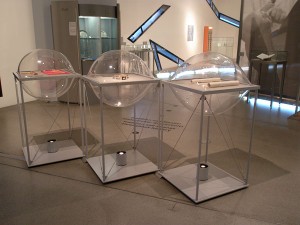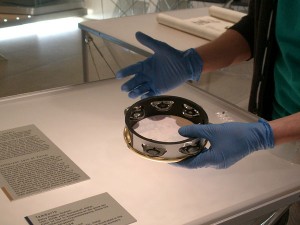In our permanent exhibition, there is a spot reserved for topics that are au courant: three prominently placed pot-bellied display windows that we call the “raviolis”.

“Ravioli” display windows in the permament exhibition © Jewish Museum Berlin, photo: Christiane Bauer
These display windows were filled once again with new exhibits for Purim, now. The new presentation looks at the festival from a feminist perspective and directs viewers’ attention to the latest developments substantially being shaped by Jewish women in the USA.
The focus of the presentation is on the two female characters of the Purim story that is read aloud at synagogue during the service: Esther and Vashti. Little attention has been paid to the latter for a long time. She was the first wife of the Persian King Ahasuerus, who cast her out because of her disobedience. He subsequently took the beautiful Jew Esther as a wife, who was shy and quiet, quite unlike the defiant Vashti. But over time Esther emerged from her reticence to transform into the courageous heroine we know, thwarting the conspiracy to murder the Persian Jews.
The story of these two dissimilar women who both revolted against male authority illuminates the feast of Purim in a special light for feminists. They have created new rituals for the feast in order not only to celebrate Esther as an inspiring example, but Vashti as well.

Placing a tambourine in our display window, USA 2008, wood, synthetic material, metal © Betsy Platkin Teutsch, photo: Christiane Bauer
The artist Susan Fischer Weis crafted an Esther-Vashti banner for a competition that specifically demonstrated this. It is supposed to be unfurled during the reading of the Purim story at synagogue as soon as the name of Esther or Vashti is spoken, and a tambourine on display also resounds in honor of the two women. This object suggests the tradition its creator, Betsy Platkin Teutsch, sees herself in: she connects the heroine of the Purim story with the icon of the American women’s movement, Rosie the Riveter. Rosie, the factory worker, is a symbol of the (professional) equality and creative potential of women.
Both sounds – the gentle rustling of a banner and the brilliant ring of a tambourine – are meant to commemorate and honor both Esther and Vashti in an appealing way. They offer a contrast to the tradition of the Purim ratchet whose noise drowns out the name of the villain during the reading of the service, with the intention of ostracizing the initiator of the murder plot and erasing him from memory.
In Germany as well, new rituals that include the female perspective have found their way into the service – although the advances of American Jewish women’s groups remain groundbreaking. Our “raviolis” show how they have transformed Purim into a festival of joy inspired by the heroic deeds of women. It would suit the occasion to rename our display windows after Hamantash pockets – the cookies baked traditionally for Purim – or even better, Esther pockets.
Christiane Bauer, Exhibitions